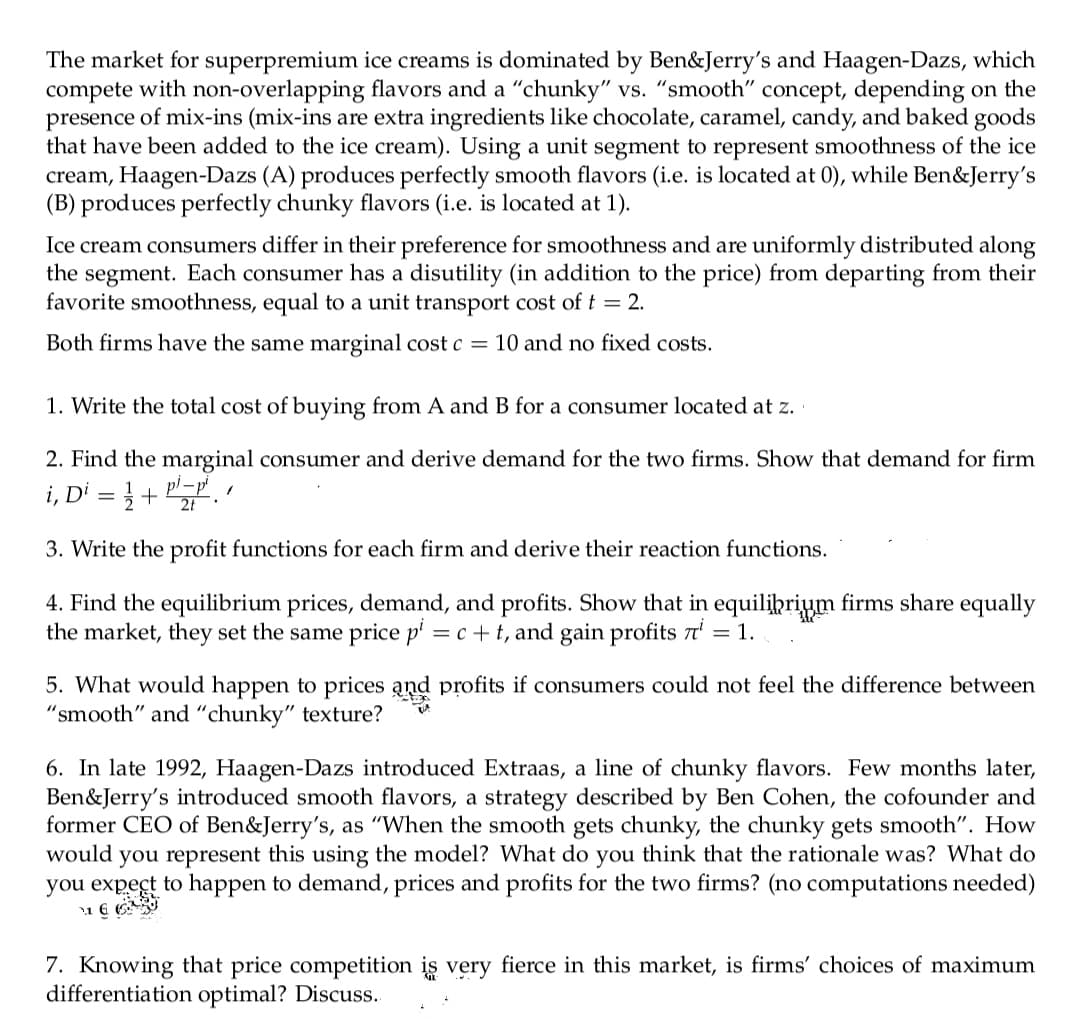The market for superpremium ice creams is dominated by Ben&Jerry's and Haagen-Dazs, which compete with non-overlapping flavors and a "chunky" vs. "smooth" concept, depending on the presence of mix-ins (mix-ins are extra ingredients like chocolate, caramel, candy, and baked goods that have been added to the ice cream). Using a unit segment to represent smoothness of the ice cream, Haagen-Dazs (A) produces perfectly smooth flavors (i.e. is located at 0), while Ben&Jerry's (B) produces perfectly chunky flavors (i.e. is located at 1). Ice cream consumers differ in their preference for smoothness and are uniformly distributed along the segment. Each consumer has a disutility (in addition to the price) from departing from their favorite smoothness, equal to a unit transport cost of t = 2. Both firms have the same marginal cost c = 10 and no fixed costs. 1. Write the total cost of buying from A and for a consumer located at z. 2. Find the marginal consumer and derive demand for the two firms. Show that demand for firm i, D' = } + P. 3. Write the profit functions for each firm and derive their reaction functions.
The market for superpremium ice creams is dominated by Ben&Jerry's and Haagen-Dazs, which compete with non-overlapping flavors and a "chunky" vs. "smooth" concept, depending on the presence of mix-ins (mix-ins are extra ingredients like chocolate, caramel, candy, and baked goods that have been added to the ice cream). Using a unit segment to represent smoothness of the ice cream, Haagen-Dazs (A) produces perfectly smooth flavors (i.e. is located at 0), while Ben&Jerry's (B) produces perfectly chunky flavors (i.e. is located at 1). Ice cream consumers differ in their preference for smoothness and are uniformly distributed along the segment. Each consumer has a disutility (in addition to the price) from departing from their favorite smoothness, equal to a unit transport cost of t = 2. Both firms have the same marginal cost c = 10 and no fixed costs. 1. Write the total cost of buying from A and for a consumer located at z. 2. Find the marginal consumer and derive demand for the two firms. Show that demand for firm i, D' = } + P. 3. Write the profit functions for each firm and derive their reaction functions.
Chapter15: Imperfect Competition
Section: Chapter Questions
Problem 15.9P
Related questions
Question

Transcribed Image Text:The market for superpremium ice creams is dominated by Ben&Jerry's and Haagen-Dazs, which
compete with non-overlapping flavors and a "chunky" vs. "smooth" concept, depending on the
presence of mix-ins (mix-ins are extra ingredients like chocolate, caramel, candy, and baked goods
that have been added to the ice cream). Using a unit segment to represent smoothness of the ice
cream, Haagen-Dazs (A) produces perfectly smooth flavors (i.e. is located at 0), while Ben&Jerry's
(B) produces perfectly chunky flavors (i.e. is located at 1).
Ice cream consumers differ in their preference for smoothness and are uniformly distributed along
the segment. Each consumer has a disutility (in addition to the price) from departing from their
favorite smoothness, equal to a unit transport cost of t = 2.
Both firms have the same marginal cost c = 10 and no fixed costs.
1. Write the total cost of buying from A and B for a consumer located at z.
2. Find the marginal consumer and derive demand for the two firms. Show that demand for firm
i, Di = } + P.
2t
3. Write the profit functions for each firm and derive their reaction functions.
4. Find the equilibrium prices, demand, and profits. Show that in equilihrium firms share equally
the market, they set the same price p' = c+ t, and gain profits t' = 1.
5. What would happen to prices and profits if consumers could not feel the difference between
"smooth" and “chunky" texture?
6. In late 1992, Haagen-Dazs introduced Extraas, a line of chunky flavors. Few months later,
Ben&Jerry's introduced smooth flavors, a strategy described by Ben Cohen, the cofounder and
former CEO of Ben&Jerry's, as "When the smooth gets chunky, the chunky gets smooth". How
would you represent this using the model? What do you think that the rationale was? What do
you expect to happen to demand, prices and profits for the two firms? (no computations needed)
7. Knowing that price competition is very fierce in this market, is firms' choices of maximum
differentiation optimal? Discuss.
Expert Solution
This question has been solved!
Explore an expertly crafted, step-by-step solution for a thorough understanding of key concepts.
This is a popular solution!
Trending now
This is a popular solution!
Step by step
Solved in 2 steps

Knowledge Booster
Learn more about
Need a deep-dive on the concept behind this application? Look no further. Learn more about this topic, economics and related others by exploring similar questions and additional content below.Recommended textbooks for you


Managerial Economics: Applications, Strategies an…
Economics
ISBN:
9781305506381
Author:
James R. McGuigan, R. Charles Moyer, Frederick H.deB. Harris
Publisher:
Cengage Learning


Managerial Economics: Applications, Strategies an…
Economics
ISBN:
9781305506381
Author:
James R. McGuigan, R. Charles Moyer, Frederick H.deB. Harris
Publisher:
Cengage Learning